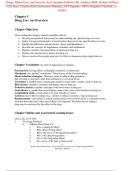Exam (elaborations)
Drugs, Behaviour, and Society 4th Canadian Edition By Andrea Hebb, Robert Gilbert, Carl Hart, Charles Ksir (Instructor Manual All Chapters, 100% Original Verified, A+ Grade)
- Course
- Institution
Drugs, Behaviour, and Society 4th Canadian Edition By Andrea Hebb, Robert Gilbert, Carl Hart, Charles Ksir (Instructor Manual All Chapters, 100% Original Verified, A+ Grade) Drugs, Behaviour, and Society 4th Canadian Edition, 4e Andrea Hebb, Robert Gilbert, Carl Hart, Charles Ksir (Instructor Ma...
[Show more]



